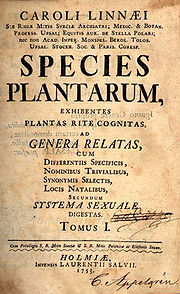 A obra Species Plantarum foi publicado pela primeira vez em 1753Lineu. É um livro importante por se tratar de um ponto de arranque para a nomenclatura botânica tal como existe hoje em dia. Algumas das características da obra são: como um trabalho de dois volumes, escrito por
A obra Species Plantarum foi publicado pela primeira vez em 1753Lineu. É um livro importante por se tratar de um ponto de arranque para a nomenclatura botânica tal como existe hoje em dia. Algumas das características da obra são: como um trabalho de dois volumes, escrito por
- continha descrição de todas as plantas conhecidas até então.
- permitia uma fácil identificação das plantas, por colocar todos os géneros em classes e ordens artificiais. Através da contagens dos pistilos e estames, mesmo alguém com pouco conhecimento de botânica conseguiria identificar a que género determinada planta pertencia.
- utilizava uma nomenclatura binomial para cada planta listada, separando desta maneira a nomenclatura botânica da taxonomia.
Esta obra sofreu numerosas edições posteriores, expandindo a sua abrangência, mesmo após a morte do seu autor original. Esta obra também marca o ponto de partida para o florescimento do interesse e popularidade da ciência, sendo uma das mais importantes publicações sobre biologia de sempre.
http://pt.wikipedia.org/wiki/Species_Plantarum ( em português)Species Plantarum ("The Species of Plants") was first published in 1753, as a two-volume work by Carl Linnaeus. Its prime importance is perhaps that it is the primary starting point of plant nomenclature as it exists today. This means that the first names to be considered validly published in botany are those that appear in this book and his Genera Plantarum ed. 5 (1753). In the book Linnaeus listed all plants known to him, directly or from his extensive reading.
The classification employed in the work allowed easy identification of plants, by placing every genus into an artificial class and order. By counting pistils and stamens, anybody, even without much knowledge of plants, was able to get to a listing of genera that the plant in question should belong to.
Linnaeus gave a formal multiple-word description to each plant and an additional epithet to be used with the genus for easier reference, thus separating taxonomy from nomenclature. For example, the tomato was described (page 185) as SOLANUM caule inermi herbaceo foliis pinnatis incisis, racemis simplicibus. The given epithet was Lycopersicum.
This was the first consistent use of naming structure for plants, and laid the basis for modern nomenclature. The binary name SOLANUM Lycopersicum (now rendered Solanum lycopersicum) very soon took over in usage because of its brevity, and the multiple-word definitions were no longer treated as formal names.
Volume 1 of the first edition covers 11 unnumbered pages of introduction and pages 1–560, while volume 2 covers pages 561–1200, plus 31 unnumbered pages of index, addenda, and errata.
After its first edition, this work went through several editions, continuing after the death of its original author. Species Plantarum also marks the starting point of a great upsurge in the popularity of science, and arguably is amongst the most important publications in biology ever.
Linnaeus himself published the second and third editions of this work. The second, in two volumes, was published in 1762–1763, with pages of corrections and supplementary material. The third edition was actually much the same as the second, but with the corrections and supplementary material integrated into the text, and was published in 1764.
After Linnaeus's death, Carl Ludwig Willdenow undertook a new, greatly expanded edition of the work. This edition was titled Editio Quarto, or "Fourth Edition", and was published in six volumes, in thirteen parts, from 1797 to 1830, and was completed after Willdenow's death. A sixth edition was published under Heinrich Friedrich Link and Albert Dietrich in two volumes in 1831–1833.
http://en.wikipedia.org/wiki/Species_Plantarum ( In English)
Nenhum comentário:
Postar um comentário